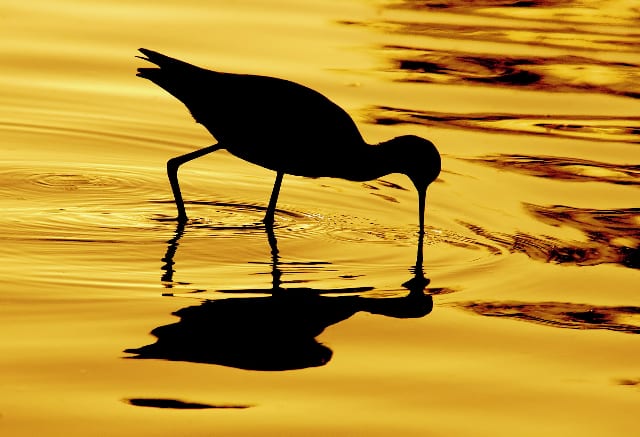Nature Just Before Dark – Webinar Question

Samantha from Sedona, AZ asks:
Q: I′m interested in capturing wild pigs. They often come out just before dark and, of course, they won′t stand still. Do you have setting suggestions?
A: It depends on your shooting style and the objective. A lot of nature and wildlife photographers use, camera blinds which are similar to shelters, blinds, tree chairs etc used by hunters. An alternative is to set up camera(s) with flash on tripods rigged with trip shutters (motion or sound sensors shutters). The problem here obviously is you can frame the photo by setting the camera position, but you cant predict exactly where the animals will go, or where it might appear in the frame (if at all). Typically you only get one or two frames before the animals are spooked by the flash. At dusk, if its bright enough to shoot without flash, you may get off a few shots using a remote shutter release (Pocket Wizard).
The best case scenario is a fast lens with a wide aperture (f 2.8, or f1.4).This will enable you to shoot in less light and with a higher shutter speed. With a lens that has a working aperture of at least f2.8 you can shoot in much lower light than with a “kit” lens (the lens that comes packaged with most DSLR cameras). The faster aperture will enable you to shoot with a shutter speed of approx 1/60 second at dusk by raising your ISO to 800, and then up to 1600 when it starts to get darker.
Unless you’re using trip shutters, or remote shutters and shooting from a blind, you still have the issue of spooking the animals. Then your best bet is a bit of camouflage (primarily finding a concealed position) and a long fast lens. Set yourself up in an area where you have seen the pigs before, or can see their recent tracks. Then using a longer lens you should be able to shoot without disturbing the pigs. This will keep them from moving as much and the long lens has the added benefit of diminishing the movement of the pigs. IE: If you are 5 feet away from a moving object it is much more difficult to keep the object in frame and focus, than if you are 200 feet away shooting with a long lens. I would suggest a tripod for the long lens as you tend to get some camera shake at that distance. An IS or VR lens will help with this but only on the camera end. IS does NOT eliminate movement of the subject, only at the camera and lens. The focal length of the lens will depend on how close you are to the animals and how large you want them to appear in frame. You can determine this by a little trial and error in daylight before shooting the animals. Set up your long fast lens and point it at a pig sized object (a Bar-B-Que?). This will determine the ideal distance between you and the pigs, to get the images you want.
The photograph below gives an example of a nature photograph using a very long lens so as not to disturb or spook the bird. The photographer, Russ Burden, a DPA instructor in Denver, has used a 360mm lens (540mm – 35mm equivalent) to achieve this.

© Russ Burden
Russ Burden has a great deal of experience leading nature workshops, (RUSS BURDEN NATURE WORKSHOP SHOULD BE LINKED HERE). This is very evident in his photograph of the bird above. The stature of the bird, the intense color, the ripples in the water, these all indicate forethought in the photograph. By photographing the bird against the bright saturated yellow water Russ has reduced the photograph to two very intense components. By making the photo simple, he has added layers of complexity and created a stunning icon for wildlife photography.
Digital Photo Academy and LivinginHD present a free monthly series of photography webinars on LivinginHD.com. Your host, John Bentham answers many questions live during the webinars. Additional questions and answers are posted here on digitalphotoacademy.com. You can also view the archived webinars for reference.
View the Oct 27, 2009, Tricky Lighting Webinar here:
http://www.digitalphotoacademy.com/Home/UserArticleCategories/UserArticles/details/params/object/9166/default.aspx



